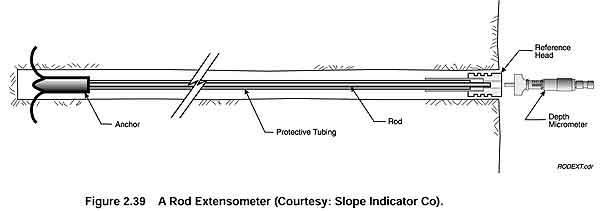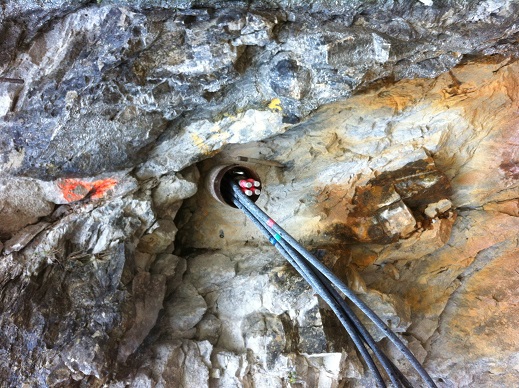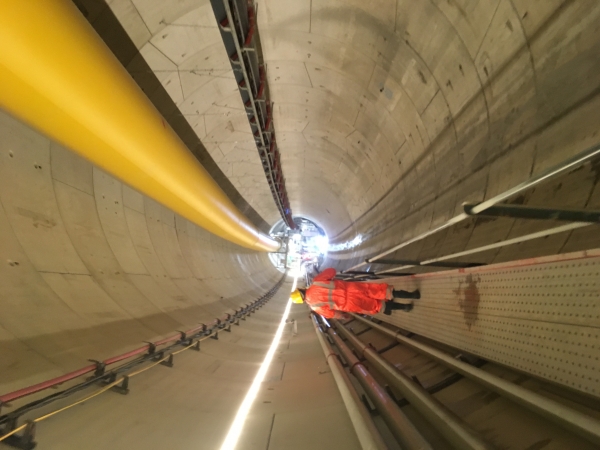Rod extensometer is a common instrument used to accurately monitor small displacements in soil, rock and concrete along axis of a borehole. It can be used to monitor the vertical or horizontal displacement of soil and rock - depending on the borehole orientation - in different geotechnical applications such as tunnels, shafts, retaining wall, natural and cut slopes, dam abutments, mining and other open excavations.In general, there are two types of rod extensometers: single point or multipoint rod extensometers. The first type measures the displacement between only one fixed point and a reference point; while, the second type measures the displacement between several fixed points and a reference. Thus, a multipoint rod extensometer can provide an accurate distribution of displacement along a borehole axis.
The rod extensometer consists of a reference head, anchors, rods and protective pipe. Each rod spans between the reference head and the anchor. The displacement between these two points, indicated by the rod, is measured at the reference head. The reading at the reference head can be done either with a gauge or a displacement transducer.
Application
The main applications of rod extensometers in geotechnical monitoring are, among others:
- Monitoring tunnel, shaft, and other underground opening stability
- Control and monitoring of displacement of retaining structures
- Monitoring subsidence above tunnels mainly in soil
- Monitoring deformation in dam abutments
- Monitoring displacement in natural and cut slope
- Monitoring deformation is walls and open pit mines
- Monitoring settlement or heave in foundations or crest of earth dam
Installation and operation
The rod extensometer consists of a reference head, anchors, rods and protective pipe. A rod extensometer may have only one rod and anchor (single point) or more than one - usually up to eight - anchors and rods (multipoint). The operation principal for both types are the same and the difference is in the quantity and precision of measured displacement data.
The rod extensometers are installed in boreholes usually drilled for this purpose. The anchors with the rods attached are installed length installed at different distances inside the borehole. The rods of different lengths are spanning between the anchors and the reference head which is located on the surface at the borehole collar. The rods are insides a pipe and protected from the backfill grout and other possible damages.
The movement of the rod between the anchored point and the reference head indicates the occurrence of movements in that zone. The displacement of the rods are measured at the reference head either with a micrometer gauge or a displacement transducer. The displacements are measured with reference to a fixed point which is often assumed to be the down-hole anchor. Reading of multiple points at the reference head provides a distribution of displacement along the borehole axis.Different types of anchors exist and can be used depending on the ground condition.
- Groutable anchors for down-hole installation in rock
- Hydraulic anchors for soft soils
- Packer anchors for jointed rocks
The extensometer rods can be either in stainless steel or fiberglass. Steel rods are used for greater depth range and can be assembled on site. Fiberglass rods are easier and quicker to install at shorter depths mainly due to their flexibility and are assembled in the factory prior to delivery to site. The reference head can often accommodate up to 6 or 8 rods. They are equipped either with micrometer gauge or displacement transducer to measure the displacements. The gauge is often used in cases where the reference head is easily accessible and less regular measurements are required; whereas, the transducer option is often used when real-time or continuous measurements are required or if the reference head cannot be easily accessed.


Advantages and Limitations
Advantages:
- An efficient way to monitor the displacement along the boreholes at any orientation
- Accurate and precise displacement measurements
- Manual or remote monitoring
- Adjustable rods according to project requirements
- Fiberglass rods easy and quick to install, advantageous specially for tunnels and underground works with limited space condition
Limitations:
- Limited range of measurement, typically up to 100 or 150 mm
- Displacements are calculated based on an assumed fixed point often considered to be the down-hole anchor. If the down-hole anchor is not really fix, the measured displacements will represent relative and not absolute values.

